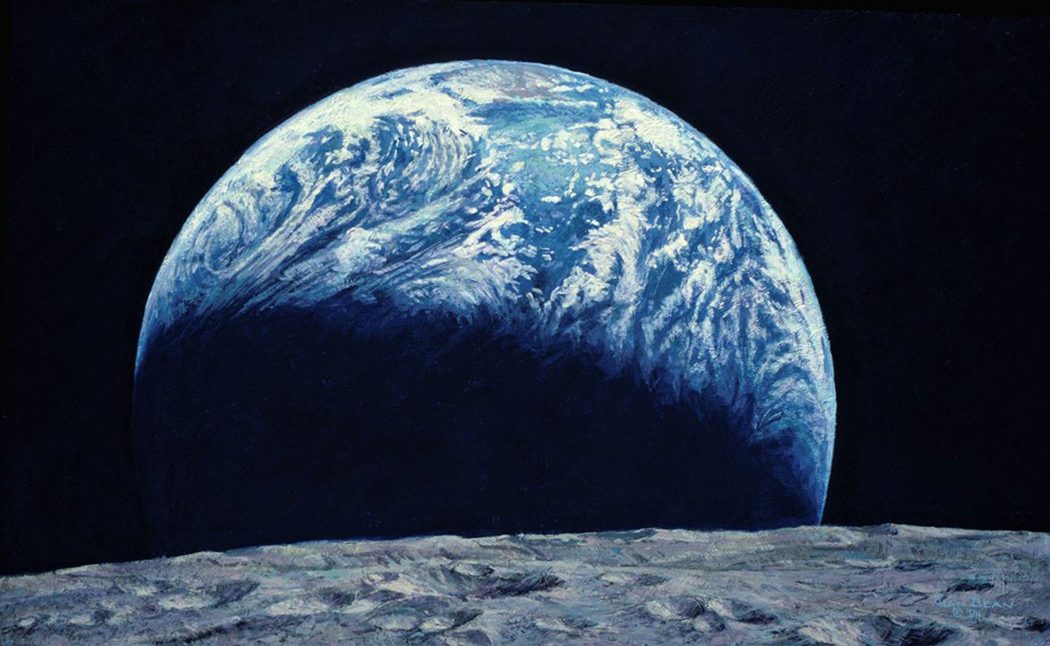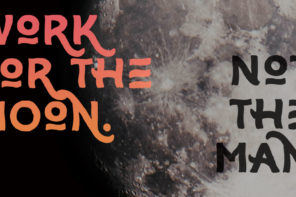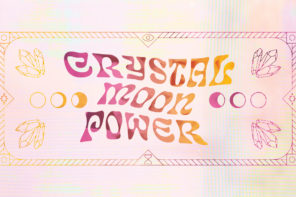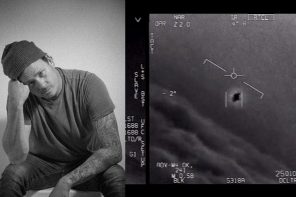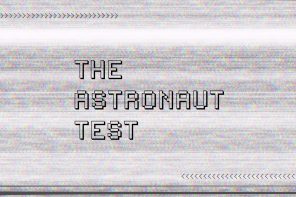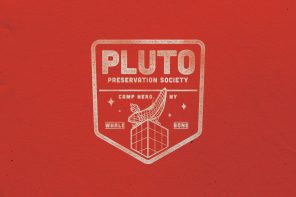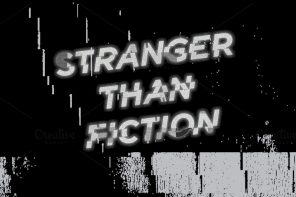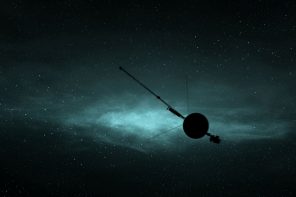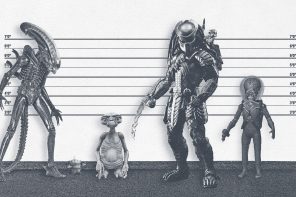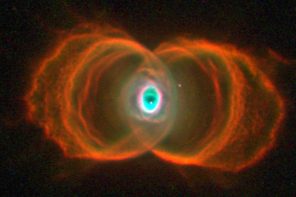A love story of the greatest astronaut on the planet and his wife
Billions of humans have lived on the planet Earth.
We suspect most of those have looked up at the moon at some point. To our knowledge, around 500,000 of those humans have applied to be professional astronauts across various space exploration programs, out of those, only 540 have ever been qualified as astronauts from around the world, out of those,24 have actually visited the moon with only 12 humans to have ever walked on the moon. Out of those twelve, only one of them had the creative ability and vision to capture and preserve his experiences of space travel through painting. His name was Alan Bean and he was the fourth person to ever walk on the moon.The name Alan Bean also humbly carries a satchel full of other accomplishments, enough to fill billions of lifetimes, such as commander of Skylab, dinners at the White House, International Space Hall of Fame, Godfrey L. Cabot Award, lifelong friends, top-ranking Navy test pilot, over 69 days logged in space with NASA, the admiration and respect of some of the most trusted minds in space exploration and aeronautical engineering. But as we started to develop this Space Issue of Whalebone Magazine we discovered something about Alan Bean that was even more impressive than his passion for flying fast planes, his natural mix of humility and humor, and his ability to paint timeless pieces of history for the world to see, it was Leslie Bean, his wife of 43 years and the story of their love for one another.
As Leslie told us the story of the first time she met Alan, it was at a church service back in the 1970s (although she proclaims neither she nor Alan was exactly the church-goer type back then) and she was therewith some friends. The church service ended and her group went to a local spot outside of Houston, where she was approached by a man who asked her out.
As Leslie Bean explains, “I wouldn’t go out with him because I was convinced that he would be an egomaniac and I had done that, been there and done that with two professional athletes I had dated, and I was not about to do that again. So I just applied that to him, but he was very, very tenacious and he would call me every day about the same time to ask me out. And I always said, No, thank you. It was very regimented, very military from that perspective. One day I agreed but I got cold feet and canceled the first two dates, and had a terrible day at work when the third try was scheduled. I told him I was going home and didn’t want to speak to anyone, didn’t want anyone in my space and planned to have a ‘grungy’ evening at home alone with my dog, DoodleBug. I told him that meant I would put on my cut-offs, and not comb my hair or brush my teeth—GRUNGY. He told me he loved grungy evenings, that he would come ‘grungy,’ bring a bottle of wine, we could share one glass of wine, we didn’t have to speak, and then he would go home and not bother me again. At the appointed time, he knocked, I looked through the peep-hole to see it was him in his mirrored aviator sunglasses. I opened the door, and he stood there smiling, in his tuxedo, with red, white and blue suspenders, and cumberbund, white tennis shoes (no one wore white tennis shoes except on the court in those days), and he carried a very beat-up brown leather briefcase, with the wine inside. I knew Iwas in trouble…who shows up in a tuxedo to a grungy date at home? I love that kind of sense of irreverent humor. By the way, Alan always disliked wine. He asked me to marry him five weeks later.”
Alan achieved quite a few honors in his career with NASA, but in 1981 he decided to leave NASA to pursue his love of painting. “He could have been a teacher or a garbage man for all I cared as long as he was happy, that’s what mattered. But knowing Alan when he puts his mind to something, it gets done,” said Leslie.
He said, ‘I do paint the moon for you, and I paint it because of you.’
Some years later, after Alan started painting the following happened, according to Leslie:
“This must be prefaced by the fact that Alan LOVED music—mainly music with a strong and loud beat, like rock and roll, or gospel or bluegrass, but he could not carry a tune to save his life. He often stood in front of his easel, with the music turned up loud, and went into that ‘zone’ of creation with paintbrush in hand, bouncing to the beat, and singing totally off-key at the top of his lungs, with soul—you see, the music was in his heart, but his vocal cords never got the message. It never deterred him.
“Around 20 years ago, maybe not quite that many years, someone we didn’t know [Darren Hayman of Hefner] wrote and recorded a song named ‘Alan Bean.’ It was recorded on a cassette tape, and if I recall, there were a lot of songs on the cassette, and the first one on the cassette was named, ‘Alan Bean.’ We tried to listen to it, but couldn’t understand the words, so Alan put the cassette in a drawer.
“A friend of Alan’s listened to it and wrote down the lyrics for him, unbeknownst to me, and Alan liked them… he referred to it as ‘Leslie’s song.’ One day, Alan grabbed a can of Coca Cola—for his microphone—grabbed the paper with the lyrics, kicked off his shoes, and presented himself in the living room where I was working, with the can of Coke in one hand, the lyrics on paper in the other hand, and in his Gold Toe socks, began to sing it to me in his best Tom Jones imitation. It was very silly and very sweet. As he finished the line, ‘I’m going to paint the moon for you,’ he pulled me into his arms, and told me it’s all been for me—from the start. He said, ‘I do paint the moon for you, and I paint it because of you.’ He told me, as he had often, that he would not have had the courage to do it if I had not believed in him.He told me the words were perfect and intended from him to me.”
There were a lot of songs on the cassette, and the first one on the cassette was named, ‘Alan Bean.’
Press play to hear “Alan Bean”
Ever felt like giving up?
I’ve felt like giving up. But not since 1969.
I found a greater truth, at a godly altitude,
Won’t waste another day of my life.
As we tumbled down to earth,
We felt the capsule turn,
We saw the blue skies burn.
As we splashed down in the sea,
You were praying on your knees,
It bought a change in me.
Everyone will forget soon,
The fourth man on the moon,
But I’ve got it in my mind.
I’d like to paint your eyes, but I’ve got to paint the sky.
Going to be a painter all my life.
–Alan Bean, by Hefner
Leslie Bean Explains
“When Alan asked me to marry him, he asked me if I would be willing to live in a tiny one-bedroom apartment, on not much money so he could try to become an artist. Iwas always proud of him and all he had done, but I didn’t care, I loved the man, and I respected the man I knew him to be. He was a man of principle and character and kindness, and that was what mattered. Alan had been an exemplary naval aviator and test pilot and became an astronaut, had walked on the moon and commanded the second Skylab mission, and was the backup commander for the Apollo-Soyuz mission. He had thought if he left the astronaut program the next ‘mountain’ he should climb was to become a successful businessman and make a lot of money and he thought he could paint as a hobby and if he was wildly successful in business he could then embark on a fourth career, as an artist. I knew, in his heart, he felt more drawn to art than to business, but he also wanted to achieve the goal of financial success, and he did not believe he could attain that goal as an artist—or even if he could succeed as an artist.
I knew, in his heart, he felt more drawn to art than to business.
“He loved art. As a boy, the model airplanes he built were chosen not only because of their technical and mechanical features but also their beauty. He began to wonder if he could make art his profession, but he worried he would not become as financially successful as he could in business. He went back and forth about it, although he would not reveal his indecision or his worries with others, I knew he agonized over the decision. I told him that I did not care if he made a lot of money—only that he did something he loved—that we would have plenty enough.
“So we lived in that tiny one-bedroom apartment, we didn’t buy new cars. I had never before felt so adored, and I adored him. We worked hard, we laughed every day, and we lived a simple life.
As the years went on, Alan inevitably started making a living on his paintings. Leslie continued,“Through the years he would tell me his success was possible because I believed in him. When he received awards he gave them to me saying he only got it because of me and our love. He believed in himself too, of course, but knowing I was his biggest fan was very important for him. For instance, when we were up in Ohio at the Museum of American Art, they did a show retrospective on Alan, it was his first museum show. And they gave him this metal that was the size of his hand, a gold medal. And he was so proud of that. It was in a red valour box, and it was an award for achievement in art. We were packing to go home the next day and he tossed it in my suitcase and I thought he just didn’t have room in his, and I said, ‘You’ve got lots of room in your suitcase.’ And he said, ‘No, this is yours. I got this because of you.’ He said, ‘All of this is because of you.’ And he told me that so many times, and it felt good. It felt good because I knew he loved what he did.”
—Leslie Bean
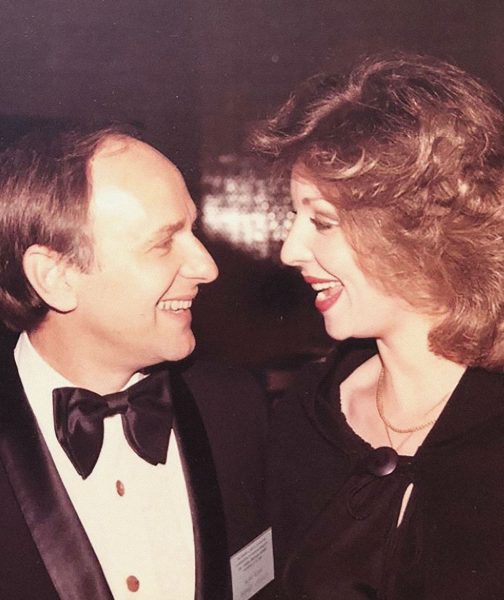
Leslie and Alan Bean
We further asked Leslie what she thought the greatest accomplishment was of having a 40-year marriage. She replied, “I think our lives are sort of like a giant tapestry. And the warp and the weave, sometimes you can’t see the threads. Sometimes you can, sometimes they’re very colorful. You may not know anything about fabrics—they call it warp and weft, and I always think of life that way. And I always thought that Alan and I had the most beautiful warp and weft, because not that we didn’t get mad at each other. We did, we got really mad at each other sometimes, but you never ever went to bed without saying, ‘Look, I don’t agree with you, but here’s the deal.’ So we always said, ‘I’m sorry.’ We always said, ‘I understand where you’re coming from.’ And we didn’t do a lot of that. It was always nice to know somebody had your back. I always felt totally supported. Alan always felt totally supported. It’s just kind of a boring thing really. The only amazing thing about the relationship between Leslie andAlan is that Alan was an astronaut. I got to seethings and experience things that I would never have gotten to see and experience before. And I’m very grateful, it was very interesting. I got to meet the man who saved the stuff in the Louvre and goto his house in Paris. He invited us to his house and we spent the whole afternoon with him. And I mean, there’s just all kinds of things. And so that was an education in and of itself. But Alan was always the focus of all of this, you see? And I was always a little stunned that he was so proud of me.I mean, I was nobody.
There are lessons to be learned from a couple that can face odds that might seem insurmountable but are able to overcome and fix things, and that is one thing the story of Alan and Leslie Bean seemed to radiate—that you fix things and you keep going and you can have fun while you’re doing it. We managed to ask her a few last things about the secret to other-worldly kind of love: “Alan has a hand-written sign on his desk that says, “treat everyone with loving-kindness. And he always tried to do that but here are some of mine: Gratitude and admiration. Acknowledging and focusing on the things that you admire in your partner. Finding and focusing on those. Listen with an open heart.Be willing to be wrong. Admit when you are wrong.Admit when your partner is or was right. If you love rock climbing and your partner is afraid of heights, do not expect them to try to like it. Go rock climbing with rock climbing friends. Don’t ask someone to change or become different. People don’t change. People don’t want to change who they are.Honor who they are. In the beginning, Alan thoughtI should fold towels exactly the way he folded them. I just smiled, watched and told him it was wonderful and that was a good job for him. He was initially shocked at my response, but he got the message that I had not ‘enlisted’ and my way was just as good even if different. In the end, nothing is as important as that other person, and often, our stubbornness is simply a way to get them to prove how important they are to you.”
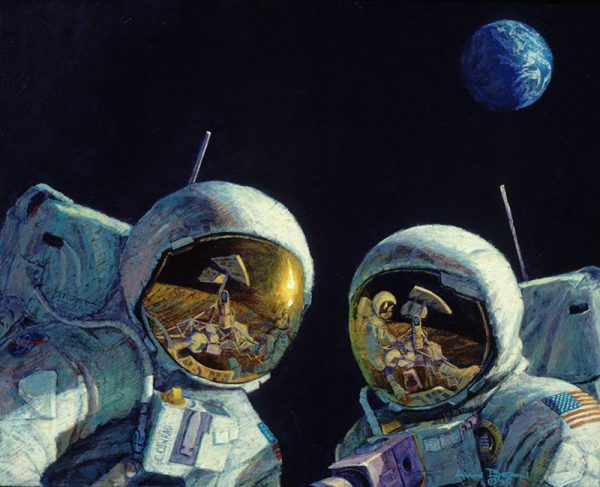
Painting by Alan Bean
HERE’S WHAT A FEW OF THE FOLKS WHO KNEW ALAN BEAN AS AN ASTRONAUT AND ARTIST HAD TO SAY:
“Alan and I have been best friends for 55 years—ever since the day we became astronauts. When I became head of the Skylab Branch of the Astronaut Office, we worked together and Alan eventually commanded the second Skylab mission. We have never lived more than a couple of miles apart, even after we left NASA. And for years,Alan and I never missed a month where we did not have a cheeseburger together at Miller’s Café in Houston.” – WALTER CUNNINGHAM, NASA ASTRONAUT, APOLLO 7 CREW
“Alan Bean and his astro artistry recreate the drama and excitement of man’s exploration of the moon as only could be chronicled by one who has been there.” – NEIL ARMSTRONG, APOLLO ASTRONAUT
“These paintings capture the spirit of our highest hopes and aspirations. As a nation, we set our sights to accomplish a near-impossible goal of walking on the moon. Only one artist was present to witness and tell the story.” – BUZZ ALDRIN, APOLLO ASTRONAUT
“What one must understand about Alan Bean is that he is the only artist to have ever walked on the moon. No poet has ever been to the lunar surface, nor any journalist, architect nor songwriter. In the realm of the arts, it has fallen upon Alan Bean to be the one moonwalker to turn hard data brought back from the moon into something other than numbered photographs. The images that Al has committed to canvas, then, are important, inspiring, and priceless works of art. Not only has he painted the moon, he’s been there.” – TOM HANKS, ACTOR AND ACADEMY AWARD WINNER
“Alan Bean was the most extraordinary person I ever met. He was a one-of-a-kind combination of technical achievement as an astronaut and artistic achievement as a painter. But what was truly extraordinary was his deep caring for others and his willingness to inspire and teach by sharing his personal journey so openly.Anyone who had the opportunity to know Alan was abetter person for it, and we were better astronauts by following his example. I am so grateful he was my mentor and friend.” – MIKE MASSIMINO, NASA ASTRONAUT

